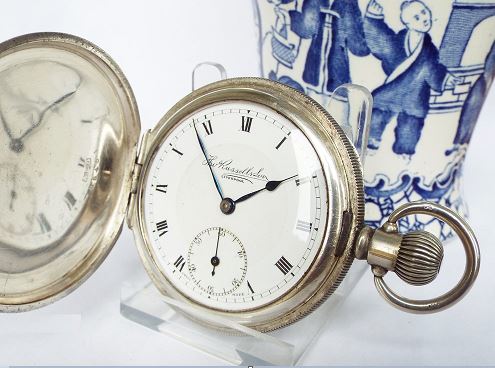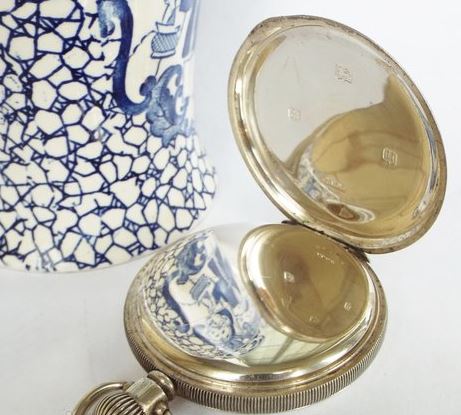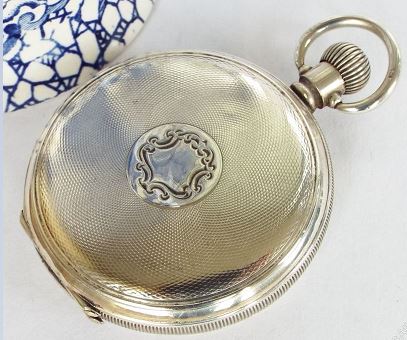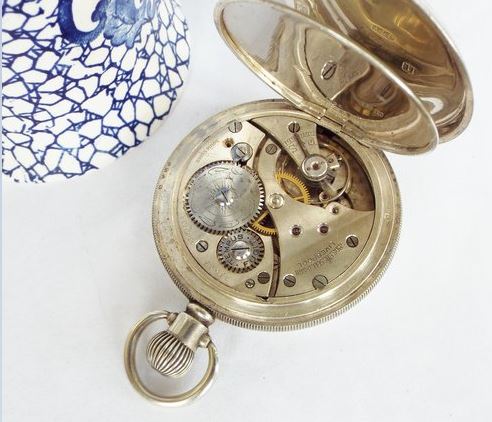Last updated on July 13, 2024
As I have mentioned in a couple of recent posts, I am looking for a hunter-cased pocket watch to add to my collection. My preference would be for a gold antique hunter case pocket watch. As of yet, I have been unable to find something suitable, but I have only been looking for the past couple of weeks. This post is about an antique hunter pocket watch from Thomas Russell, which had, unfortunately, been sold by the time that I had discovered it.
This an antique full-hunter pocket watch from Thomas Russell & Son. It’s a nice-looking watch, which I assume is gold plated because there are some signs of the base metal showing through the gold. It is possible that it is filled-gold or rolled-gold and its been heavily used so that the heavier gold layers have been worn away. I don’t mind signs of wear and tear on my antique watches. It’s a sign that the watch has actually been a practical tool and not just spent a hundred years sitting in a cupboard drawer.

Hunter vs half-hunter case
I have never been a fan of the half-hunter case. The whole idea of the case is to protect the dial, so a smaller dial seems to me to be duplicating the problem. Any damage to the lens on a half-hunter case will still obscure the view of the time. However, at some point, I am going to have to purchase a half-hunter case, just to complete the collection. Anyway, that is a discussion for another time, back to the watch in question.
Thomas Russell & Son is a very reputable watchmaker and this timepiece is a perfect example of their work. This particular watch has a signed stem-winding movement which according to the seller is working very nicely. An antique pocket watch, after decades of use, is going to show some signs of age, so it can’t be expected to keep time as accurately as a modern watch. However, this particular watch is keeping time to within two to three minutes a day, perfectly acceptable for an antique watch. The movement is protected by an inner hinged cover which reportedly has a few scratches where it has been opened in the past. Again, not a problem.
Thomas Russell & Son
The company name of Thomas Russell & Son was established in 1859 when Thomas Russell (who was listed as a watchmaker as early as 1848) handed over the control of the business to Thomas Robert Russell and Alfred Holgate Russell. The company was very well respected and successful and they earned a Royal Warrant, ‘Makers to Queen Victoria’. They continued to benefit from this Warrant even after it ceased upon Victoria’s death in 1901, although the continued use was only tolerated for a short period.

After the partnership split, Thomas Russell continued as the proprietor of the Russell Watch & Chronometer Manufactory and Alfred Russell continued as Thomas Russell & Son. Thomas Russell & Son achieved a Royal Warrant as makers to the Queen and the Duke of Edinburgh. In 1881 they started importing watches from Switzerland.
By 1938, the firm had become Thomas Russell & Son Watch Co Ltd. The watches were often branded as Thos. Russell & Son as ‘Thos.’ was considered an acceptable abbreviation of the name Thomas. It probably also freed up some space on the watch dial.
Case and condition
The watch measures 52mm in diameter excluding the winding stem and the loop. The case is silver. There are hallmarks inside the multiple case backs for Birmingham 1919 with a case maker’s mark for Aaron Dennison who supplied quality cases to many different watch companies. The case has engine turned detail to both the front and back and it is still nice and crisp. There are a few minor signs of damage, but the timepiece remains perfectly presentable.

The winding crown pushes in to release the front cover, without assistance This is something I am looking for in a hunter-case pocket watch. After many years of use, the lid spring that allows the front cover to open can wear. This often means that the lid needs to be opened manually. I certainly want a useable antique pocket watch where the lid spring opens automatically. To preserve the lid spring, it is important to remember to depress the crown when closing the lid.
Dial and acrylic lens
Inside the open cover is an original watch crystal which is in good condition. Quite often, the mineral glass has been broken and it has been replaced with an acrylic lens. Acrylic was invented in 1928 and is more durable than mineral glass, although much more likely to scratch. Mineral glass is highly likely to shatter if dropped, however, is relatively scratch resistant. Modern sapphire crystal lenses are very durable and virtually scratch-resistant. The signed dial is in a good nice condition with no blemishes visible to the naked eye.
It has blued steel hands, a subsidiary second’s dial and an outer minute track. Bluing steel is a process that tempers the steel and creates a blue coating that helps to prevent the hands from rusting. First, the steel hands are cleaned and polished. Next, the hands are heated, over a bed of brass filings, to a high temperature. The layer of brass filings is used to maintain a stable temperature exchange. The steel changes colour from gold to brown and then purple before it settles to blue.
Movement
The movement is stamped with the maker’s name, Thos. Russell & Son. It is a Swiss Made, 15 jewel movement. According to the seller it is running within 2 – 3 minutes of accuracy per day, which is perfectly acceptable for an antique timepiece. The movement is clean with no signs of damage or erosion.

It’s a great looking antique pocket watch from a respected maker and therefore would have met all of my requirements. It is presentable, reliable and in great overall condition. If I had the chance, I would have purchased this excellent antique pocket watch. Unfortunately for me, some other collector is enjoying this timepiece.

Hi Jason I have a pocket watch here if you could shed some light on the watch was made by Thomas Russell company in Liverpool 18 church road serial number 105763 many thanks Paul .
Hi Paul, I am not aware of any definitive database for Thomas Russell serial numbers. From the examples I have seen with known dates the serial numbers don’t seem to follow a set pattern. The Thomas Russell company moved to Church road around 1877, so the watch certainly dates after that time. Otherwise, does your watch show any British hallmarks on the case? That would be the most accurate way of dating the watch. Thanks, Jason